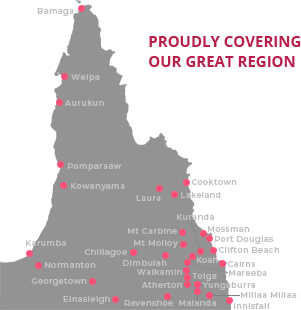General News
1 October, 2025
Water concerns over Peeramon development
DEVELOPERS who want to create 13 rural residential lots at Peeramon will have to demonstrate there is another groundwater before Tablelands Regional Council will give it final approval. NOTE: The previous image used with this article did not depict the development discussed in the article.

The development was the subject of a deputation last week to council by neighbouring landholders who do not believe there is enough water to cater to 13 more lots and a large farming operation that is expected to be established by the end of the year.
Eden Rutherford-Delben and Blake Rutherford told council that the aquifer was already under pressure during the dry months of the year and, despite having rainwater tanks, landholders were often forced to buy water to supply their properties.
Ms Rutherford-Delben said her family had been living in the area for 40 years and even though they had capacity to store 85,000 litres of water, they needed to access bores to provide enough supply.
“Every year, on our three acres, we still require bore water to supplement our storage and every year, I speak to people in my community whose bores run dry and tanks are empty,” she said.
“There is no such thing as water security in Peeramon and by the end of the year, there will be an additional 25,000 avocado trees on farming land across the valley contributing to the lack thereof.
“For further housing development to take place in Peeramon township, council should be obliged to provide facilities and services – create housing opportunities by all means, but in doing so, at least accommodate the basic requirements afforded by other communities.
“Developers and town planners have found the perfect loophole that puts responsibility for housing infrastructure back on individual landholders with little recourse when such things as water security have not been appropriately addressed.”
In line with other objections to the development, Ms Rutherford-Delben was also concerned about impacts from stormwater runoff that was currently managed through three 100-year-old culverts under the railway line which “struggled to cope now”.
“On paper, this development ticks all the boxes. In reality, there are too many factors that remain unknown and a detrimental impact on our properties is inevitable,” she said.
“In his response, the developer recognises our concerns as valid but brushes them off with vague planning submission strategies.”
She also criticised the way planning officers assessed how the new lots would affect existing landholders without even coming to their properties, and incorrectly stating in the report that there was only grazing land to the east and west of the proposed development when there were existing dwellings, including her own.
“(The developer’s) disregard mirrored by town planners’ failure to attempt to approach us to access our properties to make an accurate assessment confuses me and assumes an arrogance that is disrespectful and dismissive,” Ms Rutherford-Delben said.
Councillors heeded their concerns, questioning a planning officer as to how the council would ensure that the aquifer could accommodate the additional need from 13 new properties.
He told the council the developer would need to demonstrate that all lots were able to be provided with a reliable source of water satisfying a minimum daily demand via rainwater tanks and bores.
Before approving the reconfiguration of the lot into 13 lots, councillors amended the resolution to guarantee that evidence that adequate water could be provided would be put to the full council before the project could go ahead.


